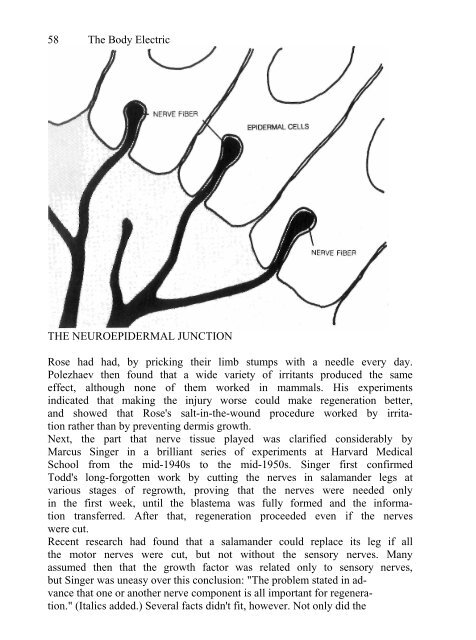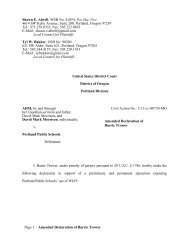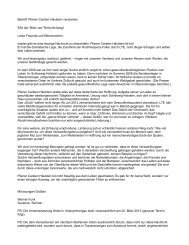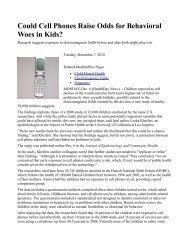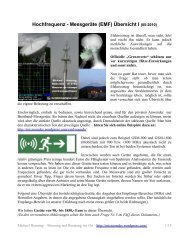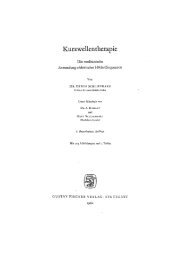- Page 2 and 3: Contents Acknowledgments 7 Co-autho
- Page 4 and 5: Contents 13 14 Breathing with the E
- Page 6 and 7: 18 The Body Electric the patient's
- Page 8 and 9: 20 The Body Electric technology's r
- Page 10 and 11: Part 1 Growth and Regrowth Salamand
- Page 12 and 13: 26 The Body Electric gold mine for
- Page 14 and 15: 28 The Body Electric laugh therapy
- Page 16 and 17: 30 The Body Electric weeks if the e
- Page 18 and 19: 32 The Body Electric gun to wonder
- Page 20 and 21: 34 The Body Electric TREMBLEY'S DIS
- Page 22 and 23: 36 The Body Electric A HYDRA REGROW
- Page 24 and 25: 38 The Body Electric hobby. In a ca
- Page 26 and 27: Two I The Embryo at the Wound Rener
- Page 28 and 29: 42 The Body Electric half of the pr
- Page 30 and 31: 44 The Body Electric At first this
- Page 32 and 33: 46 The Body Electric DIFFERENTIATIO
- Page 34 and 35: 48 The Body Electric because of the
- Page 36 and 37: 50 The Body Electric put into a hin
- Page 38 and 39: 52 The Body Electric FORMING A TWO-
- Page 40 and 41: 54 The Body Electric present is the
- Page 42 and 43: 56 The Body Electric near one of th
- Page 46 and 47: 60 The Body Electric possibility wa
- Page 48 and 49: 62 The Body Electric the plant's ow
- Page 50 and 51: 64 The Body Electric In the long ru
- Page 52 and 53: 66 The Body Electric stein maintain
- Page 54 and 55: Three The Sign of the Miracle Real
- Page 56 and 57: 70 The Body Electric "It's not here
- Page 58 and 59: 72 The Body Electric the inferior a
- Page 60 and 61: 74 The Body Electric the current of
- Page 62 and 63: 76 The Body Electric Rose himself.
- Page 64 and 65: Four Life's Potentials It's an axio
- Page 66 and 67: Life's Potentials 81 object. The fi
- Page 68 and 69: Life's Potentials 83 override the c
- Page 70 and 71: Life's Potentials 85 MARSH AND BEAM
- Page 72 and 73: Life's Potentials 87 Another proble
- Page 74 and 75: Life's Potentials 89 One of the mat
- Page 76 and 77: Life's Potentials 91 implying a cur
- Page 78 and 79: Life's Potentials 93 number of elec
- Page 80 and 81: Life's Potentials 95 ELECTRICAL MEA
- Page 82 and 83: Life's Potentials 97 and seemed to
- Page 84 and 85: Life's Potentials 99 THE DC FIELD N
- Page 86 and 87: Life's Potentials 101 netic field,
- Page 88 and 89: Five The Circuit of Awareness Charl
- Page 90 and 91: The Circuit of Awareness 105 He was
- Page 92 and 93: The Circuit of Awareness 107 had co
- Page 94 and 95:
The Circuit of Awareness 109 I said
- Page 96 and 97:
The Circuit of Awareness 111 Certai
- Page 98 and 99:
The Circuit of Awareness 113 slow w
- Page 100 and 101:
The Circuit of Awareness 115 I allo
- Page 102 and 103:
The Circuit of Awareness 117 in the
- Page 104 and 105:
The Ticklish Gene 119 ago was a rem
- Page 106 and 107:
The Ticklish Gene 121 BONES-DESIGNE
- Page 108 and 109:
The Ticklish Gene 123 the negative
- Page 110 and 111:
The Ticklish Gene 125 around the ne
- Page 112 and 113:
The Ticklish Gene 127 tunately, the
- Page 114 and 115:
The Ticklish Gene 129 THE LIGHT TES
- Page 116 and 117:
The Ticklish Gene 131 This was the
- Page 118 and 119:
The Ticklish Gene 133 experiment: W
- Page 120 and 121:
The Ticklish Gene 135 supplied plen
- Page 122 and 123:
The Ticklish Gene 137 it so as to o
- Page 124 and 125:
The Ticklish Gene 139 most no nerve
- Page 126 and 127:
The Ticklish Gene 141 was any way h
- Page 128 and 129:
The Ticklish Gene 143 chamber. In f
- Page 130 and 131:
The Ticklish Gene 145 ruary 1967 I
- Page 132 and 133:
The Ticklish Gene 147 iosteum.* At
- Page 134 and 135:
The Ticklish Gene 149 the surroundi
- Page 136 and 137:
Good News for Mammals 151 Smith imp
- Page 138 and 139:
Good News for Mammals 153 off the e
- Page 140 and 141:
Good News for Mammals 155 small. Ph
- Page 142 and 143:
Good News for Mammats 157 This disc
- Page 144 and 145:
Good News for Mammals 159 current c
- Page 146 and 147:
Part 3 Our Hidden Healing Energy Di
- Page 148 and 149:
164 The Body Electric broke both le
- Page 150 and 151:
166 The Body Electric Jim in a walk
- Page 152 and 153:
168 The Body Electric multinational
- Page 154 and 155:
170 The Body Electric any bacteria
- Page 156 and 157:
172 The Body Electric bone with pos
- Page 158 and 159:
174 The Body Electric To learn more
- Page 160 and 161:
176 The Body Electric nents. Of cou
- Page 162 and 163:
178 The Body Electric exposure to t
- Page 164 and 165:
180 The Body Electric niques to rep
- Page 166 and 167:
182 The Body Electric whole organis
- Page 168 and 169:
184 The Body Electric There's still
- Page 170 and 171:
186 The Body Electric tude and forc
- Page 172 and 173:
188 The Body Electric With orthoped
- Page 174 and 175:
190 The Body Electric shown that th
- Page 176 and 177:
192 The Body Electric around, and t
- Page 178 and 179:
194 The Body Electric jumped threef
- Page 180 and 181:
Ten The Lazarus Heart Like Columbus
- Page 182 and 183:
198 The Body Electric mitotic compo
- Page 184 and 185:
200 The Body Electric the water thr
- Page 186 and 187:
202 The Body Electric Personally, I
- Page 188 and 189:
204 The Body Electric to send the i
- Page 190 and 191:
206 The Body Electric point of inhi
- Page 192 and 193:
208 The Body Electric from the regu
- Page 194 and 195:
210 The Body Electric mendously exa
- Page 196 and 197:
212 The Body Electric ferent input
- Page 198 and 199:
214 The Body Electric ing at the si
- Page 200 and 201:
216 The Body Electric disease: The
- Page 202 and 203:
218 The Body Electric that cancer c
- Page 204 and 205:
220 The Body Electric ing hierarchy
- Page 206 and 207:
222 The Body Electric Stephanie Mat
- Page 208 and 209:
224 The Body Electric support this
- Page 210 and 211:
Part 4 The Essence of Life And if t
- Page 212 and 213:
230 The Body Electric be humble bef
- Page 214 and 215:
232 The Body Electric missing a cha
- Page 216 and 217:
234 The Body Electric some of us wo
- Page 218 and 219:
236 The Body Electric matching the
- Page 220 and 221:
238 The Body Electric Unifying Path
- Page 222 and 223:
240 The Body Electric conveys infor
- Page 224 and 225:
242 The Body Electric thus just as
- Page 226 and 227:
244 The Body Electric I was an orth
- Page 228 and 229:
246 The Body Electric his surprise,
- Page 230 and 231:
248 The Body Electric flop in polar
- Page 232 and 233:
250 The Body Electric We likely hav
- Page 234 and 235:
252 The Body Electric blocked the s
- Page 236 and 237:
254 The Body Electric describe anom
- Page 238 and 239:
256 The Body Electric years after t
- Page 240 and 241:
258 The Body Electric rebuilding, p
- Page 242 and 243:
260 The Body Electric California ha
- Page 244 and 245:
262 The Body Electric plankton anim
- Page 246 and 247:
264 The Body Electric tively, and t
- Page 248 and 249:
266 The Body Electric field around
- Page 250 and 251:
268 The Body Electric around other
- Page 252 and 253:
270 The Body Electric losopher Pier
- Page 254 and 255:
272 The Body Electric outward-flowi
- Page 256 and 257:
274 The Body Electric Everything th
- Page 258 and 259:
276 The Body Electric higher one do
- Page 260 and 261:
278 The Body Electric effects of on
- Page 262 and 263:
280 The Body Electric As soon as I
- Page 264 and 265:
282 The Body Electric committee, wr
- Page 266 and 267:
284 The Body Electric appeals of th
- Page 268 and 269:
286 The Body Electric 320 microwatt
- Page 270 and 271:
288 The Body Electric wires. We fou
- Page 272 and 273:
290 The Body Electric transient com
- Page 274 and 275:
292 The Body Electric The only comp
- Page 276 and 277:
294 The Body Electric The admittedl
- Page 278 and 279:
296 The Body Electric That situatio
- Page 280 and 281:
298 The Body Electric found chromos
- Page 282 and 283:
300 The Body Electric by surveys in
- Page 284 and 285:
302 The Body Electric source in TH-
- Page 286 and 287:
304 The Body Electric Arthur Frank,
- Page 288 and 289:
306 The Body Electric the face of c
- Page 290 and 291:
308 The Body Electric that nontherm
- Page 292 and 293:
310 The Body Electric Table 2. EMF
- Page 294 and 295:
312 The Body Electric be expected.
- Page 296 and 297:
314 The Body Electric ping frequenc
- Page 298 and 299:
316 The Body Electric nal was a com
- Page 300 and 301:
318 The Body Electric ons Laborator
- Page 302 and 303:
320 The Body Electric of the cage,
- Page 304 and 305:
322 The Body Electric In a third te
- Page 306 and 307:
324 The Body Electric of naval rese
- Page 308 and 309:
326 The Body Electric audio amplifi
- Page 310 and 311:
328 The Body Electric leading to ou
- Page 312 and 313:
Postscript: Political Science An im
- Page 314 and 315:
332 The Body Electric weighted in f
- Page 316 and 317:
334 The Body Electric the reports o
- Page 318 and 319:
336 The Body Electric Before I bega
- Page 320 and 321:
338 The Body Electric VA research f
- Page 322 and 323:
340 The Body Electric clearly state
- Page 324 and 325:
342 The Body Electric lem, but neve
- Page 326 and 327:
344 The Body Electric posed experim
- Page 328 and 329:
346 The Body Electric in writing, a
- Page 330 and 331:
Glossary Apatite: The mineral fract
- Page 332 and 333:
350 The Body Electric Galvanotaxis:
- Page 334:
352 The Body Electric Semiconductio


